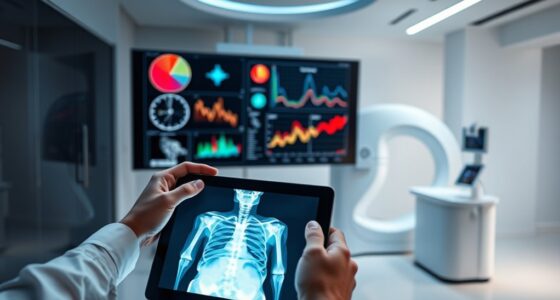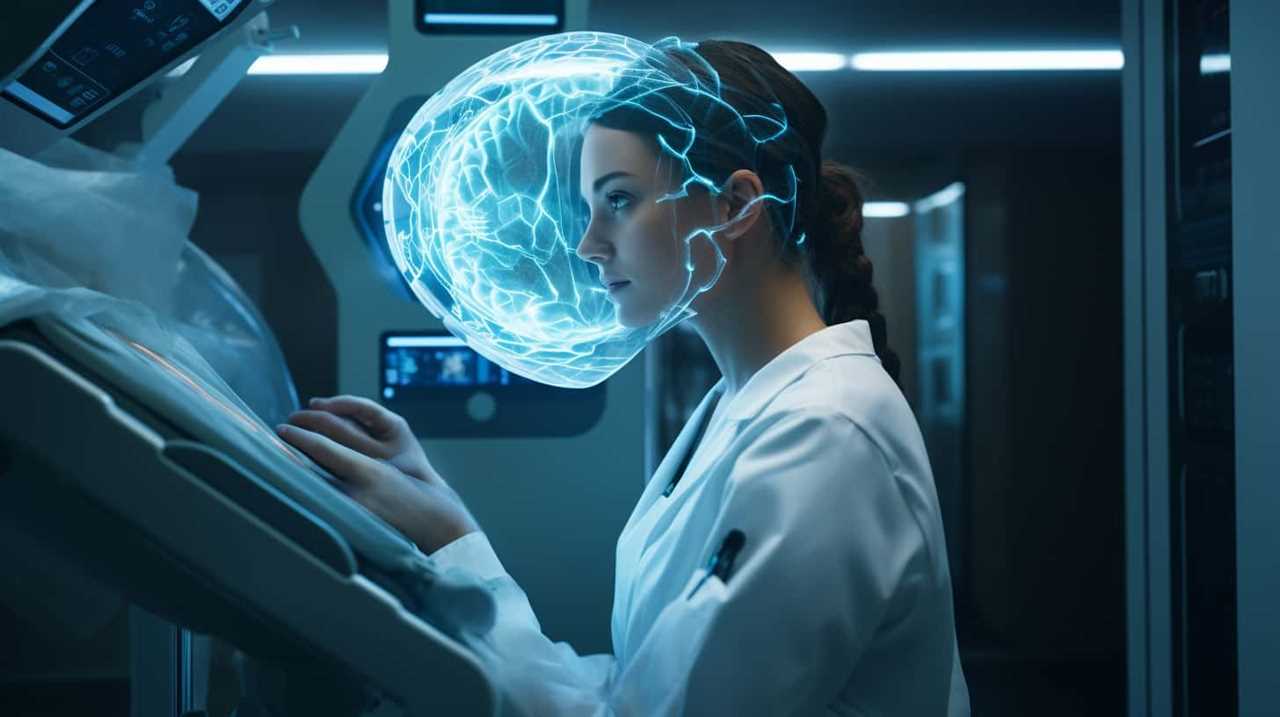In the ever-changing realm of medicine, **artificial intelligence (AI)** in medical imaging acts like a magnifying glass, helping us reveal hidden details that were once hard to find. Discover the magic of AI and unlock secrets within medical images. Explore the endless possibilities and broaden your horizon in the medical field. Unleash the power of technology and dive deeper into the world of medical imaging with AI by your side. Keep reading to learn more about this groundbreaking technology and its immense benefits for medical professionals and patients alike.
With AI, we are not only enhancing the accuracy of medical diagnoses, but also improving treatment planning efficiency.
Furthermore, AI aids us in the early detection of diseases and conditions, paving the way for personalized and targeted therapies.
Join us as we delve into the four remarkable ways medical imaging AI boosts diagnosis and treatment.

Key Takeaways
- Medical imaging AI improves the accuracy of medical diagnoses.
- AI algorithms streamline treatment planning and save time and effort.
- AI aids in the early detection of diseases and conditions.
- Medical imaging AI enables personalized and targeted therapies.
Enhanced Accuracy in Medical Diagnoses
One key benefit of medical imaging AI is its ability to significantly improve the accuracy of medical diagnoses. This enhanced accuracy leads to increased patient satisfaction and reduced healthcare costs.
By using artificial intelligence algorithms, medical imaging AI can analyze medical images with a level of precision that surpasses human capabilities. This technology can detect subtle abnormalities and patterns that might be missed by even the most skilled radiologists.
With more accurate diagnoses, patients can receive timely and appropriate treatment, leading to better outcomes and higher satisfaction rates. Additionally, improved accuracy can help avoid unnecessary tests and procedures, reducing healthcare costs.
The integration of medical imaging AI into the diagnostic process not only enhances accuracy but also contributes to improved efficiency in treatment planning, as we’ll discuss in the next section.

Improved Efficiency in Treatment Planning
To improve efficiency in treatment planning, we utilize the power of medical imaging AI to streamline the process and optimize patient care. By incorporating AI into our workflows, we can achieve streamlined workflows and make the most of our optimized resources.
Here’s how medical imaging AI helps enhance efficiency in treatment planning:
- Automated analysis: Medical imaging AI algorithms can quickly analyze large volumes of medical images, reducing the time and effort required by healthcare professionals.
- Decision support: AI-powered tools can provide valuable insights and recommendations to aid in treatment planning, helping healthcare providers make informed decisions.
- Resource allocation: With AI assistance, healthcare facilities can better allocate their resources, ensuring that patients receive the necessary treatments in a timely manner.
By leveraging the capabilities of medical imaging AI, we can significantly improve the efficiency of treatment planning, ultimately leading to better patient outcomes.
Moving forward, let’s explore how AI contributes to the early detection of diseases and conditions.

Early Detection of Diseases and Conditions
In our experience, medical imaging AI greatly aids in the early detection of diseases and conditions. By utilizing cutting-edge technology, AI algorithms are able to analyze medical images and identify subtle abnormalities that may indicate the presence of a disease or condition at its earliest stages. This allows healthcare professionals to intervene earlier, resulting in more effective prevention strategies and improved patient outcomes.
The ability of medical imaging AI to detect diseases and conditions in their early stages is crucial for implementing personalized and targeted therapies. With early detection, healthcare providers can tailor treatment plans to the specific needs of each patient, increasing the chances of successful outcomes. By identifying diseases and conditions earlier, medical imaging AI plays a vital role in improving overall patient care and reducing the burden on healthcare systems.
Transitioning to the next section about personalized and targeted therapies, the early detection made possible by medical imaging AI opens the door to more precise and individualized treatment approaches.
Personalized and Targeted Therapies
Medical imaging AI enables us to customize and focus treatments for individual patients, leading to more effective outcomes. By harnessing the power of AI, we can tailor therapies to the specific needs of each patient, taking into account their unique characteristics and conditions. This approach, known as precision medicine, holds great promise in revolutionizing healthcare.

Here are two key ways in which medical imaging AI facilitates personalized and targeted therapies:
- Individualized Medications:
- AI algorithms can analyze medical images to identify biomarkers and genetic markers that indicate a patient’s response to certain medications.
- This allows doctors to prescribe medications that are specifically tailored to an individual’s genetic makeup, increasing the likelihood of successful treatment.
- Precision Medicine:
- Medical imaging AI can help identify the most suitable treatment options for patients based on their specific conditions, taking into account factors such as tumor size, location, and characteristics.
- This enables healthcare professionals to develop personalized treatment plans that optimize outcomes and minimize side effects.
Through the integration of medical imaging AI, we can unlock the potential of individualized medications and precision medicine, paving the way for more targeted and effective therapies.
Frequently Asked Questions
How Does Medical Imaging AI Enhance Accuracy in Medical Diagnoses?
Enhancing diagnostic accuracy and improving patient outcomes are key benefits of medical imaging AI. By analyzing medical images with advanced algorithms, AI can detect subtle abnormalities that may be missed by human eye, leading to more accurate diagnoses and better treatment decisions.
What Are the Benefits of Improved Efficiency in Treatment Planning Through Medical Imaging Ai?
Improved efficiency in treatment planning through medical imaging AI leads to enhanced treatment effectiveness and improved patient outcomes. It streamlines the process, allowing for faster and more accurate diagnosis, resulting in better-targeted treatments and ultimately saving lives.

How Does Medical Imaging AI Contribute to Early Detection of Diseases and Conditions?
Medical imaging AI contributes to early detection of diseases and conditions by analyzing medical images with advanced algorithms. This enables us to identify subtle signs and patterns, facilitating early intervention and leading to improved patient outcomes.
What Are Some Examples of Personalized and Targeted Therapies Enabled by Medical Imaging Ai?
Personalized treatments and targeted therapies are made possible by medical imaging AI. It allows us to tailor treatments specifically to individual patients, based on the information gathered from advanced imaging techniques.
Can Medical Imaging AI Be Integrated With Existing Healthcare Systems for Better Patient Outcomes?
Yes, medical imaging AI can be integrated with existing healthcare systems for better patient outcomes. However, there are integration challenges and potential limitations that need to be addressed to ensure seamless implementation and maximize the benefits of this technology.
Conclusion
In conclusion, the integration of AI in medical imaging has revolutionized the field of diagnosis and treatment. With enhanced accuracy in diagnoses, medical professionals can provide more efficient and personalized care to patients.

The early detection of diseases and conditions allows for timely interventions, potentially saving lives. Moreover, AI enables precise treatment planning, leading to better outcomes.
As we embrace this technological advancement, we can envision a future where medical imaging AI coincides seamlessly with human expertise, creating a harmonious symphony of healthcare excellence.











